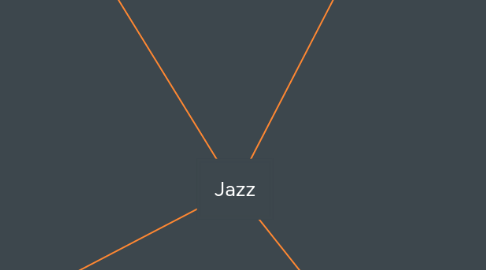
1. Bebop
1.1. Complex
1.1.1. Sophisticated Harmonies
1.1.2. Varied, Unpredictable Rhythms
1.2. 4-6 Players
1.2.1. Saxophone
1.2.2. Trumpet
1.2.3. Rhythm Section
1.2.3.1. Piano
1.2.3.2. Pizzicato Bass
1.2.3.3. Percussion
1.2.3.3.1. Ride Cymbal
1.3. Made for Attentive Listening, not Dancing
1.4. Named for Vocalization of the two Fast Notes (be-bop)
1.5. Began and Ended with Statement of Main Theme by
1.5.1. One Soloist
1.5.2. Two Soloists in Unison
1.6. Charlie Parker
1.7. Thelonious Monk
1.7.1. Thelonious Monk "Epistrophy" (1957)
1.8. Dizzy Gillespie
2. Roots of Jazz
2.1. Blues
2.1.1. Important Foundation for Jazz
2.1.2. Born from African American Folk Songs
2.1.2.1. Work Songs
2.1.2.2. Spirituals
2.1.2.3. Field Hollers
2.1.3. Acoustic Guitar Accompaniment
2.1.4. Intensely Personal
2.1.4.1. Sexual References
2.1.4.2. Betrayal
2.1.4.3. Desertion
2.1.4.4. Unrequited Love
2.1.5. 3-Line Stanzas
2.1.6. Bessie Smith
2.1.6.1. Bessie Smith-Lost Your Head Blues
2.2. Ragtime
2.2.1. Composed Piano Music
2.2.2. Duple Meter
2.2.3. Moderate March Tempo
2.2.4. Scott Joplin
2.2.4.1. "King of Ragtime"
2.2.4.2. Maple Leaf Rag Played by Scott Joplin
2.3. Brass Bands
2.3.1. Used Instruments from Marching Bands
2.3.1.1. Trumpet
2.3.1.2. Cornet
2.3.1.3. Trombone
2.3.1.4. Tuba
2.3.1.5. Clarinet
2.3.1.6. Drums
3. Early Jazz
3.1. New Orleans
3.1.1. Small Group of 5-8 Players
3.1.1.1. Front Line
3.1.1.1.1. Cornet
3.1.1.1.2. Trumpet
3.1.1.1.3. Clarinet
3.1.1.1.4. Trombone
3.1.1.2. Rhythm Section
3.1.1.2.1. Drums
3.1.1.2.2. Chordal Instruments
3.1.1.2.3. Single-Line Low Instruments
3.1.2. Breaks
3.1.2.1. Brief Unaccompanied Solos
3.1.3. Tag
3.1.4. Louis Armstrong
3.1.4.1. Louis Armstrong- Hotter Than That
3.2. Chicago
3.2.1. Joe "King" Oliver
3.2.2. Ferdinand "Jelly Roll" Morton
3.2.3. Emphasis on Solo Choruses
3.2.4. Faster Tempos
3.2.5. Band
3.2.5.1. String Bass
3.2.5.2. Guitar
3.2.5.3. Saxophone
4. Swing
4.1. Big Bands
4.1.1. 14-15 Musicians
4.1.1.1. 3-5 Saxophones
4.1.1.1.1. Riffs
4.1.1.2. Brass Instruments
4.1.1.2.1. 3-4 Trumpets
4.1.1.2.2. 3-4 Trombones
4.1.1.3. Rhythm
4.1.1.3.1. Piano
4.1.1.3.2. Percussion
4.1.1.3.3. Guitar
4.1.1.3.4. Bass
4.2. More Composed than Improvised
4.3. Arranged
4.3.1. Written-Out Parts for Each Musician to Read
4.4. Melodies performed by entire sections
4.4.1. In Unison
4.4.2. In Harmony
4.5. Rich Harmonic Vocabulary
4.6. Duke Ellington
4.6.1. Duke Ellington - C Jam Blues (1942)

